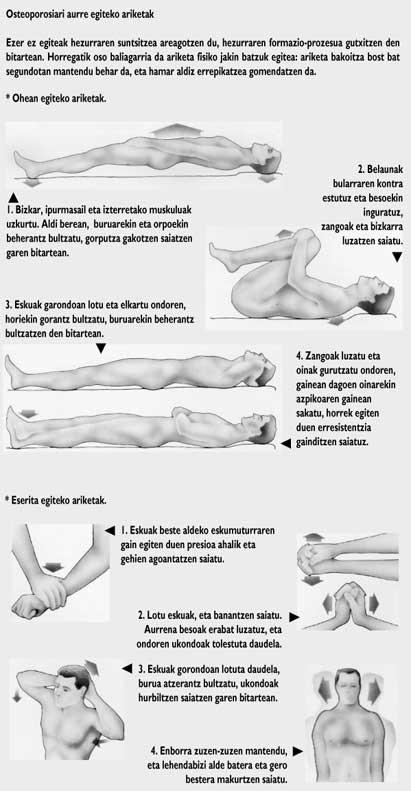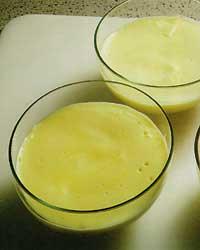Osteoporosis, silent plague
1995/04/01 Agirre, Jabier - Medikua eta OEEko kidea Iturria: Elhuyar aldizkaria
On the other hand, the tendency of the disease is growing, since at the same time as life expectancy increases, it also increases the number of people osteoporosis: thus, in less than ten years, half of the women who have passed menopause and 50% of people over 75 will be affected by osteoporosis. However, a good diet and, above all, rich in calcium, can radically change the situation.
Prevalence of osteoporosis

Osteoporosis is the most frequent metabolic disease in western societies, derived from an imbalance between the processes of resorption and formation in bone. This imbalance causes a loss of mass in the bone. In the first phase of life, calcium helps to complete and increase bone. Subsequently, at the maturity of the person, calcium maintains and promotes bone balance and, finally, in old age, when they are more active than those that form the cells that raise the bone, calcium represents the physical loss of the bone. Bone is a living structure formed by an organic matrix on which calcium, phosphates and some minerals are deposited. The loss of bone mass not only implies the weakening of the body retention system, but the loss of minerals so necessary.
At present, 50% of postmenopausal women and half of those older than 75 years (men and women) are considered to be affected by osteoporosis.
And osteoporosis is divided into two large groups:
- Primary osteoporosis on the one hand. In this case, there is no reason or causal disease (postmenopausal and old age osteoporosis would enter here).
- Secondary osteoporosis, on the other hand, is caused by a certain agent or disease, and more than a special disease, would be a component of the clinical picture.
Factors that condition osteoporosis
The individual factors that facilitate the appearance of osteoporosis are many: the white race, age, sex (more in women), those related to nutrition, hormonal alterations, as well as those related to the environment (low sun exposure or lack of physical exercise). Other risk factors are intermittent (in women, of course), early menopause, or lack of estrogen, a family history of osteoporosis, low body weight, smoking, or alcoholism.
Is there prevention?

If the picture so far was dark, there are currently simple and simple measures that can help us maintain bone health and avoid osteoporosis. These prevention measures should begin in childhood or youth to continue throughout life. The diet rich in calcium and the regular practice of physical exercise are the key to prevention. Walking, running, playing tennis or dancing are very important for building an adequate bone structure in youth and maintaining bone health throughout your life. Moderate consumption of alcohol and tobacco is also important in prevention.
Treatment with estrogens can be beneficial in postmenopausal women at risk of osteoporosis. And if estrogens are counterconditioned other drugs, such as calcitomin, they are useful to combat bone mass loss and also to treat working osteoporosis.
In the case of elderly people, it is advisable to adopt a series of measures to avoid possible falls that can cause fractures. It is necessary to make the house more secure, removing the carpets from the road and placing paths so that they do not slip or slip: place handles in stairs and bathtubs, improve the system of argicontra, etc. Periodic eye and ear control is also important to avoid falls.
But without underscoring all the previous measures, the food measure occupies a fundamental place in prevention. And in general it can be said that a person needs every day one gram of calcium, half a gram for babies without having completed one year and 1,500 milligrams for older than 60 years. But adolescents, pregnant women, and infants should take more than 1,200 milligrams daily.
What should we take?
The diet rich in dairy, including ice cream, includes some fish, vegetables and legumes, and nuts, are simple sources of calcium and not expensive.

This gram, mentioned above, is not difficult to obtain if we consider, for example, that sardine 100 g provides 300 mg of calcium (and 400 mg of oil). The same is provided by the lady (a ration of 100 grams). Cured or semi-cured cheese also provides a lot of calcium (100 g of cheese almost 800 mg of calcium) and after dessert a cup of milk (even more with a little honey or chocolate powder) provides another 300 mg of calcium. The 1,000 milligrams of the whole day are made (and surplus).
And foods rich in calcium (see table) are not angry with being rich. Except azeitun or olive, all other foods (including cocoa and nuts) do not have a lot of calories.
To cover the daily needs of calcium, always taking into account the age and situation of each person, it is necessary to modify certain habits both to prevent osteoporosis and to be able to coexist with osteoporosis.
- The young child should drink whole milk (not skimmed milk) with cocoa (such as Cola Cao to better understand) and smoothies or filters, made at home or based, instead of soft drinks.
- The teenager should increase calcium intake, since it is not usually very abundant in his daily meals. But that doesn't mean you have to discard the dishes you like: just add cheese to salads, pasta or burgers, and eat more ice cream, yogurt or dairy. Teenagers (and especially girls) can drink skimmed milk, due to its high calcium content.
- Young women are also very concerned about their kilos and take half of calcium from what they would need for one reason or another. Again, it should be noted that many low-calorie foods are high in calcium: cheese with salad and pasta, skimmed dairy, etc.
- In post-menopausal women, estrogen production is stopped and when more calcium is eliminated in the urine, they are at risk for osteoporosis. That is why at this age it is advisable to consume milk (whole, semi-skimmed or skimmed, empty or cocoa), dairy, yogurt or ice cream. We must not forget, of course, the vegetables, the nuts, the preserves of fish, the small fish (with their thorns, as the anchovies or the pots, since the calcium is mainly found in the bone).


Gai honi buruzko eduki gehiago
Elhuyarrek garatutako teknologia





